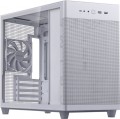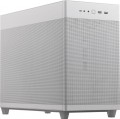Features
The direction in which the body is facing. This parameter is indicated only for models that have a certain specialization and differ markedly from general-purpose cases.
—
Gaming. Cases designed for high-performance gaming computer systems. They usually have numerous openings for expansion slots and bays for drives (see the corresponding paragraphs), as well as advanced options for installing cooling systems — many “seats” for fans, the ability to use liquid cooling (see “Liquid cooling support”) and etc. In addition, they often stand out due to their design: they can be equipped with decorative lighting, transparent windows, etc.
—
HTPC. Enclosures for PC multimedia orientation, the so-called Home Theater Personal Computer (HTPC). The characteristic features of such cases are compact size, the presence of additional buttons on the front panel for controlling multimedia (and sometimes a sensor for the remote control) and an advanced design.
Form factor
The form factor determines, first of all, the internal volume of the case (as a result, the motherboard used for it, see "Type of motherboard"), as well as installation features. To date, PC cases are available in the following main form factors:
—
Full Tower. The tower case is one of the largest form factors for PCs today: 15-20 cm wide, 50-60 cm high, with up to 10 externally accessible bays. Most often in this form factor running advanced high performance PCs.
—
Ultra Tower. Further development and expansion of Full Tower cases (see above), offering even more space for hardware: the width of such a case is about 25 cm, the height can reach 70 cm, which allows you to install powerful configurations inside and provides enough free space for effective cooling .
—
Midi Tower. A representative of the tower family (tower cases) of medium size — about 45 cm in height with a width of 15-20 cm, with the number of external bays from 2 to 4. Most popular for middle-class home PCs.
—
Mini Tower. The most compact "vertical" case type, with a width of 15-20 cm, has a height of about 35 cm and (usually) less than 2 compartments with external access. It is mainly used for assembling office PCs that do not require high performance.
—
Desktop. Enclosures designed for i
...nstallation directly on the desktop. They often have the possibility of horizontal installation — in such a way that a monitor can be placed on top of the case — although there are also models that are installed strictly vertically. The size of such cases can be almost anything — from miniature solutions for thin mini ITX motherboards to large-sized cases for E-ATX (see "Motherboard type"). However, most "desktops" are relatively small.
— Cube Case. Cases having a cubic or close to it shape. They can have different sizes and are intended for different types of motherboards, this point in each case should be clarified separately. Anyway, such cases have a rather original appearance, different from traditional "towers" and "desktops".
— Dual Tower. Quite a rare option — cases, in size and proportions resembling two "towers", made up side by side. Dual Tower solutions are large in size and are intended mainly for powerful high-performance PCs (in particular, top gaming stations).
Note that there are models that allow both vertical and horizontal installation and can, in fact, turn from a "tower" to a "desktop" and vice versa. For such cases, the form factor is indicated by the form factor named in the manufacturer's documentation, or by the main installation method described there.PSU mount
The location of the power supply (or seat for the power supply) in the case.
The traditional option is the
top location of the PSU, this is a familiar and familiar option for many. However, heated air from other system components accumulates in the top of the case, reducing cooling efficiency. Cases
with a lower location of the PSU are deprived of this drawback, however, a lot of dust and other contaminants get into them if the system unit is installed on the floor. However, this difference becomes critical only when using high-performance systems with appropriate heat dissipation; for an ordinary household PC, the location of the power supply unit as a whole is not important.
Also note that in miniature cases like mini-Tower (see "Form factor"), the PSU installed on top can overlap part of the motherboard, which further worsens the cooling efficiency and makes it difficult to install large CPU coolers; however, it all depends on the layout of a particular case.
3.5" bays
The number of internal 3.5" form factor bays provided in the design of the case. Such bays, in accordance with the name, are intended for internal components, mainly hard drives and some SSD modules; to access them, the case must be disassembled.
Theoretically, the number of bays corresponds to the maximum number of drives that can be installed in the chassis. However, in fact, the best option is to install drives through a single slot to ensure efficient cooling. Accordingly, it is best to select a case in such a way that the number of internal 3.5" bays is twice the expected number of hard drives.
Dust filter
The presence of a special filter in the housing to prevent dust from entering. Without such a filter, dust settles on the system elements; Radiators are especially susceptible to this; they also lose their efficiency by becoming clogged with dust. If you have
a dust filter, you have to clean not the “filling” of the PC, but the filter element itself, which is much simpler and more convenient.
Compartments for dust filters can be located on
the front panel of the case,
back,
bottom,
top, or
in the side walls. There are also case models with several technological niches for installing dust filters - the combined version assumes the presence of such compartments on several sides of the case at once.
Side panel window
The presence of
a viewing window on the side panel of the case, allowing you to see the “filling” without opening the case. It gives the case a stylish appearance; in addition, it allows you to install a lighting system inside, which is appreciated by gamers compared to
case models without a window.
The materials for manufacturing the windows on the side panel are:
- Acrylic. Acrylic or plexiglass is an inexpensive material of relatively light weight, which, however, actively collects scratches and can be deformed when exposed to high temperatures.
- Strained glass. Tempered glass panels have excellent transparency, are resistant to scratches and are easy to clean from dirt. At the same time, they weigh a lot and can break to pieces if not handled carefully.
- Metal grid. Wire mesh is a simple type of window material used on the side panel of a cabinet. It allows air to pass through and provides additional heat removal from the internal components of the system unit; dust can leak through the mesh overnight.
More features
—
Front cover. A hinged cover that completely or partially covers the front panel. Gives the computer a neat appearance, hiding connectors and external slots under a solid, uniform surface and performs the function of child protection.
—
Panel display. A display on the front or side panel of the case, used to display various service information: the current processor frequency, data on the system temperature, cooling operating mode, etc. Various important data can be displayed on the display without reference to what is happening in the software part of the computer.
—
Video card holder. A design solution for supporting a video card inside the case. Specialized stands or holders prevent the graphics adapter from sagging over time and reduce the load on the PCI-E slot of the motherboard. The fact is that many models of modern video cards have gained some weight - the holders are designed to compensate for their weight. Stands are available both as built-in solutions and as separate accessories that can be installed inside the case independently.
—
Side panel lock. The presence of a special lock on the removable side panel of the case. Such a lock prevents unauthorized access to the internal volume of the system unit.
—
Noise isolation. Availability at the case of
...additional sound insulation. This can be either a special coating on the inside, or other, more specific solutions (for example, damping systems on “seats” for individual components that reduce the level of vibrations transmitted to the body). Anyway, this feature helps to reduce the noise level emitted by the system — sometimes quite significantly.
— Removable basket for HDD. The presence in the design of the case of a removable basket for the inner periphery of the 3.5 "form factor (in the vast majority of cases these are hard drives, hence the name). Such a basket facilitates assembly due to the fact that it is much easier to remove it and install a hard drive inside than mount it in a non-removable compartment inside the case; this moment is especially useful if you plan to install several hard drives in the system.
— Docking station for HDD. Built-in docking station for quick connection of internal hard drives. In fact, this function allows you to connect an internal HDD as an external one: the docking station connector is located outside the case and is equipped with quick-release fasteners for easy connection.
— Concealed wiring. The ability to run wires from the power supply on the back of the motherboard (if we take the side where the processor and slots for expansion cards are located as the main one). Thus, the space on the main side of the "motherboard" is freed from wires, which, in particular, has a positive effect on the cooling efficiency.
— The window for installing the cooling system(Cooling system) for CPU. The presence of a separate window in the case opposite the CPU fasteners. The mounting system is located on the back of the motherboard, and usually, in order to change it, you need to remove the entire "motherboard"; the Cooling system installation window saves the user from such a need and greatly simplifies the installation and change of Cooling system.
